Article | BUSINESS MANAGEMENT.
VerifiedAdded on 2022/08/11
|11
|2384
|16
AI Summary
Contribute Materials
Your contribution can guide someone’s learning journey. Share your
documents today.
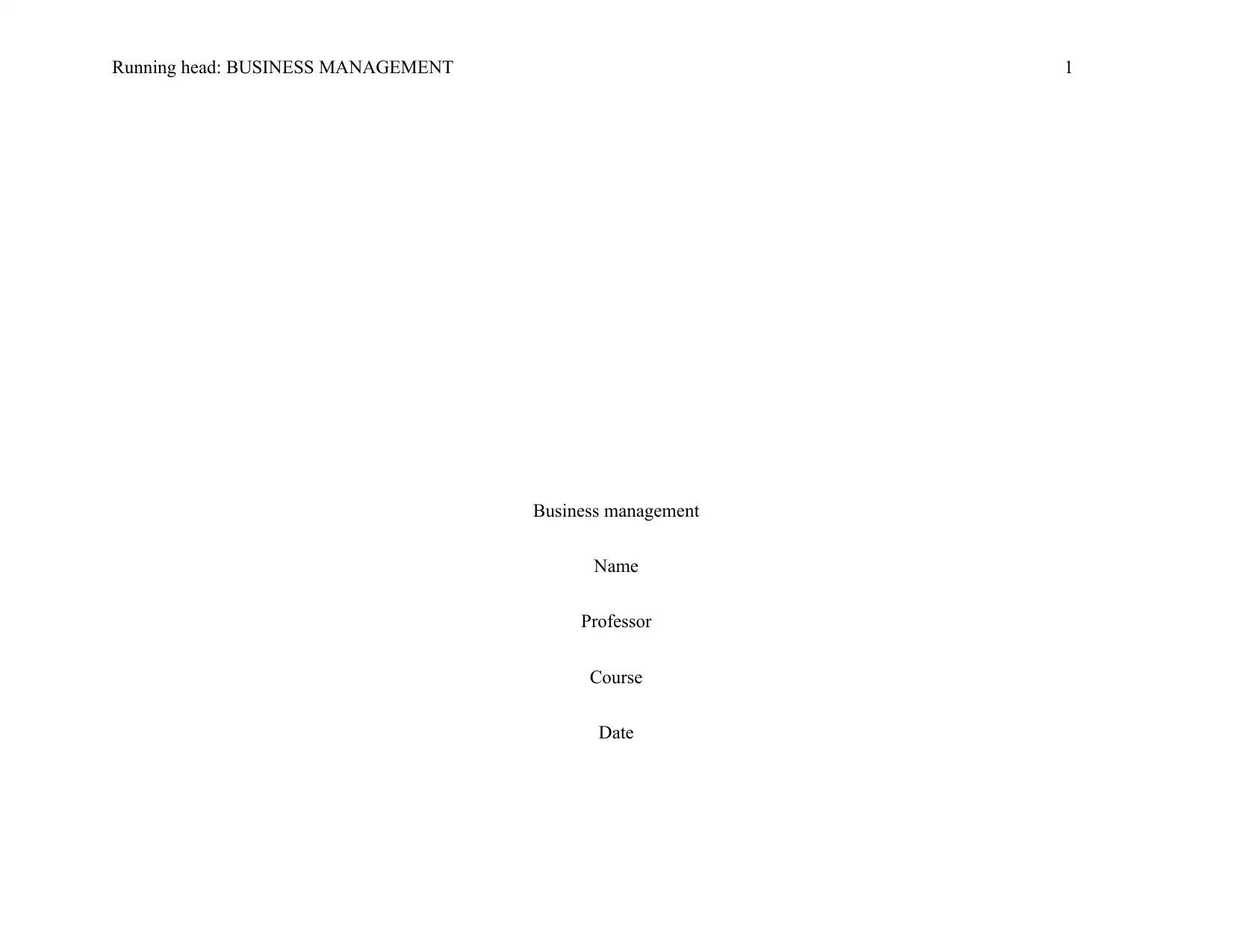
Running head: BUSINESS MANAGEMENT 1
Business management
Name
Professor
Course
Date
Business management
Name
Professor
Course
Date
Secure Best Marks with AI Grader
Need help grading? Try our AI Grader for instant feedback on your assignments.
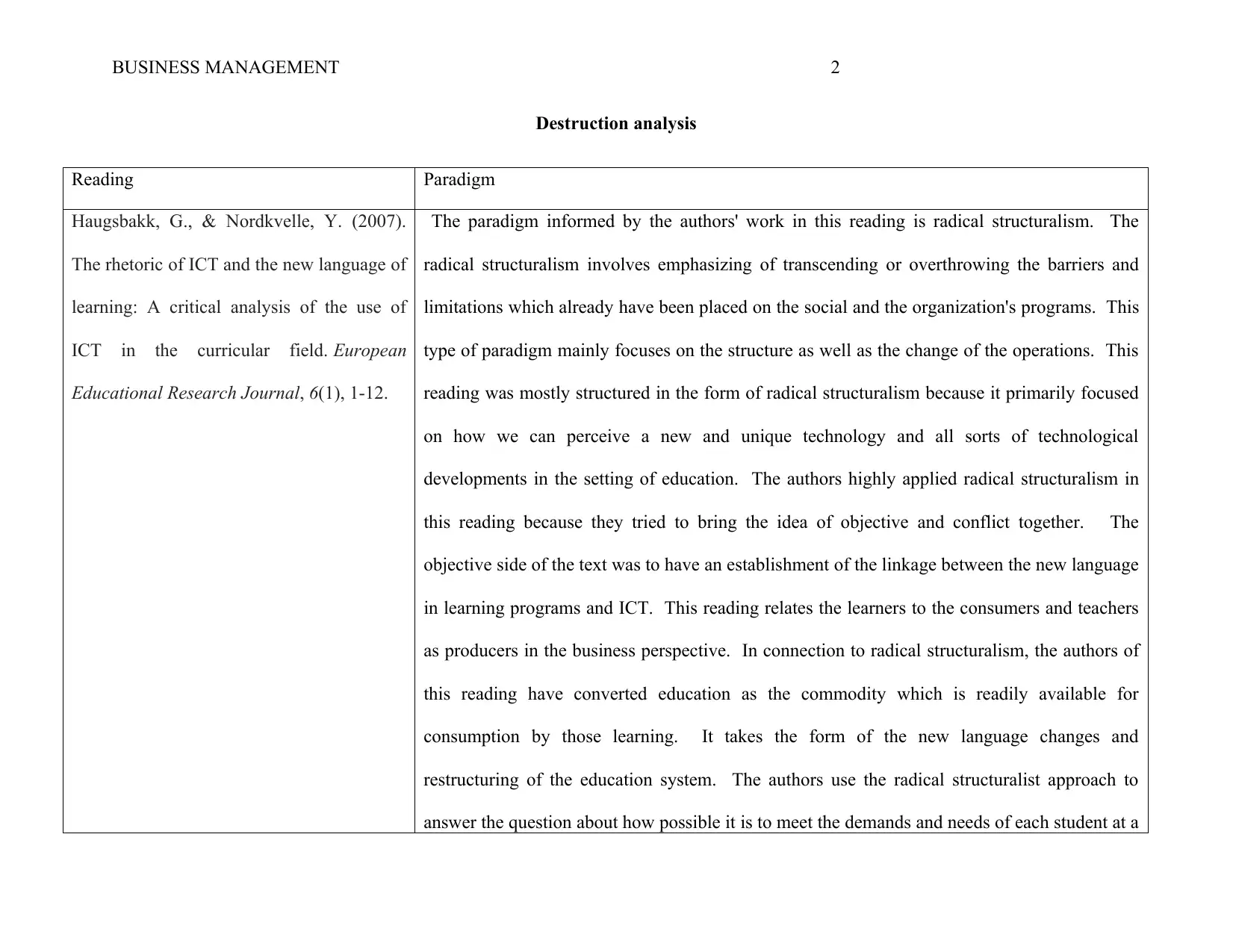
BUSINESS MANAGEMENT 2
Destruction analysis
Reading Paradigm
Haugsbakk, G., & Nordkvelle, Y. (2007).
The rhetoric of ICT and the new language of
learning: A critical analysis of the use of
ICT in the curricular field. European
Educational Research Journal, 6(1), 1-12.
The paradigm informed by the authors' work in this reading is radical structuralism. The
radical structuralism involves emphasizing of transcending or overthrowing the barriers and
limitations which already have been placed on the social and the organization's programs. This
type of paradigm mainly focuses on the structure as well as the change of the operations. This
reading was mostly structured in the form of radical structuralism because it primarily focused
on how we can perceive a new and unique technology and all sorts of technological
developments in the setting of education. The authors highly applied radical structuralism in
this reading because they tried to bring the idea of objective and conflict together. The
objective side of the text was to have an establishment of the linkage between the new language
in learning programs and ICT. This reading relates the learners to the consumers and teachers
as producers in the business perspective. In connection to radical structuralism, the authors of
this reading have converted education as the commodity which is readily available for
consumption by those learning. It takes the form of the new language changes and
restructuring of the education system. The authors use the radical structuralist approach to
answer the question about how possible it is to meet the demands and needs of each student at a
Destruction analysis
Reading Paradigm
Haugsbakk, G., & Nordkvelle, Y. (2007).
The rhetoric of ICT and the new language of
learning: A critical analysis of the use of
ICT in the curricular field. European
Educational Research Journal, 6(1), 1-12.
The paradigm informed by the authors' work in this reading is radical structuralism. The
radical structuralism involves emphasizing of transcending or overthrowing the barriers and
limitations which already have been placed on the social and the organization's programs. This
type of paradigm mainly focuses on the structure as well as the change of the operations. This
reading was mostly structured in the form of radical structuralism because it primarily focused
on how we can perceive a new and unique technology and all sorts of technological
developments in the setting of education. The authors highly applied radical structuralism in
this reading because they tried to bring the idea of objective and conflict together. The
objective side of the text was to have an establishment of the linkage between the new language
in learning programs and ICT. This reading relates the learners to the consumers and teachers
as producers in the business perspective. In connection to radical structuralism, the authors of
this reading have converted education as the commodity which is readily available for
consumption by those learning. It takes the form of the new language changes and
restructuring of the education system. The authors use the radical structuralist approach to
answer the question about how possible it is to meet the demands and needs of each student at a
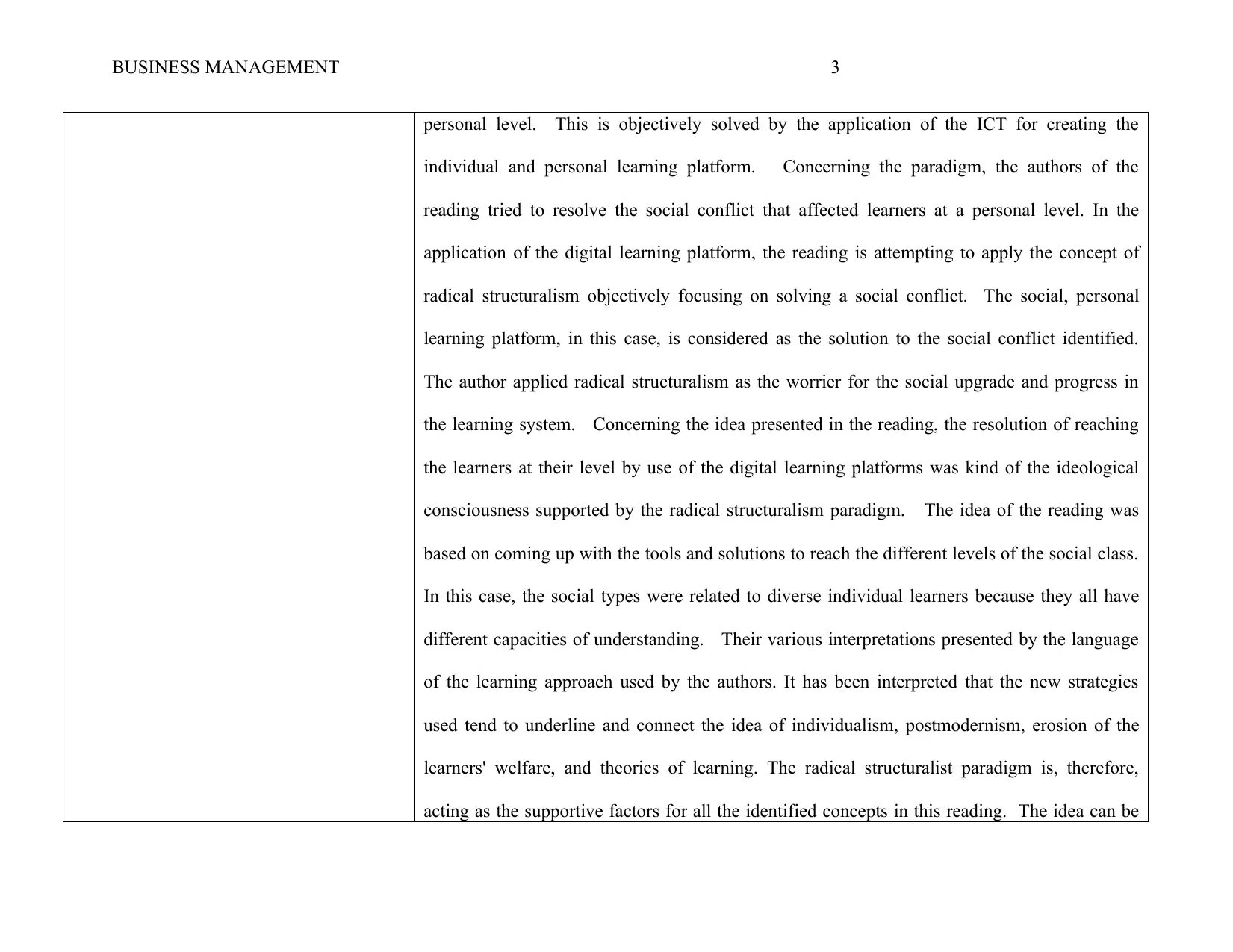
BUSINESS MANAGEMENT 3
personal level. This is objectively solved by the application of the ICT for creating the
individual and personal learning platform. Concerning the paradigm, the authors of the
reading tried to resolve the social conflict that affected learners at a personal level. In the
application of the digital learning platform, the reading is attempting to apply the concept of
radical structuralism objectively focusing on solving a social conflict. The social, personal
learning platform, in this case, is considered as the solution to the social conflict identified.
The author applied radical structuralism as the worrier for the social upgrade and progress in
the learning system. Concerning the idea presented in the reading, the resolution of reaching
the learners at their level by use of the digital learning platforms was kind of the ideological
consciousness supported by the radical structuralism paradigm. The idea of the reading was
based on coming up with the tools and solutions to reach the different levels of the social class.
In this case, the social types were related to diverse individual learners because they all have
different capacities of understanding. Their various interpretations presented by the language
of the learning approach used by the authors. It has been interpreted that the new strategies
used tend to underline and connect the idea of individualism, postmodernism, erosion of the
learners' welfare, and theories of learning. The radical structuralist paradigm is, therefore,
acting as the supportive factors for all the identified concepts in this reading. The idea can be
personal level. This is objectively solved by the application of the ICT for creating the
individual and personal learning platform. Concerning the paradigm, the authors of the
reading tried to resolve the social conflict that affected learners at a personal level. In the
application of the digital learning platform, the reading is attempting to apply the concept of
radical structuralism objectively focusing on solving a social conflict. The social, personal
learning platform, in this case, is considered as the solution to the social conflict identified.
The author applied radical structuralism as the worrier for the social upgrade and progress in
the learning system. Concerning the idea presented in the reading, the resolution of reaching
the learners at their level by use of the digital learning platforms was kind of the ideological
consciousness supported by the radical structuralism paradigm. The idea of the reading was
based on coming up with the tools and solutions to reach the different levels of the social class.
In this case, the social types were related to diverse individual learners because they all have
different capacities of understanding. Their various interpretations presented by the language
of the learning approach used by the authors. It has been interpreted that the new strategies
used tend to underline and connect the idea of individualism, postmodernism, erosion of the
learners' welfare, and theories of learning. The radical structuralist paradigm is, therefore,
acting as the supportive factors for all the identified concepts in this reading. The idea can be
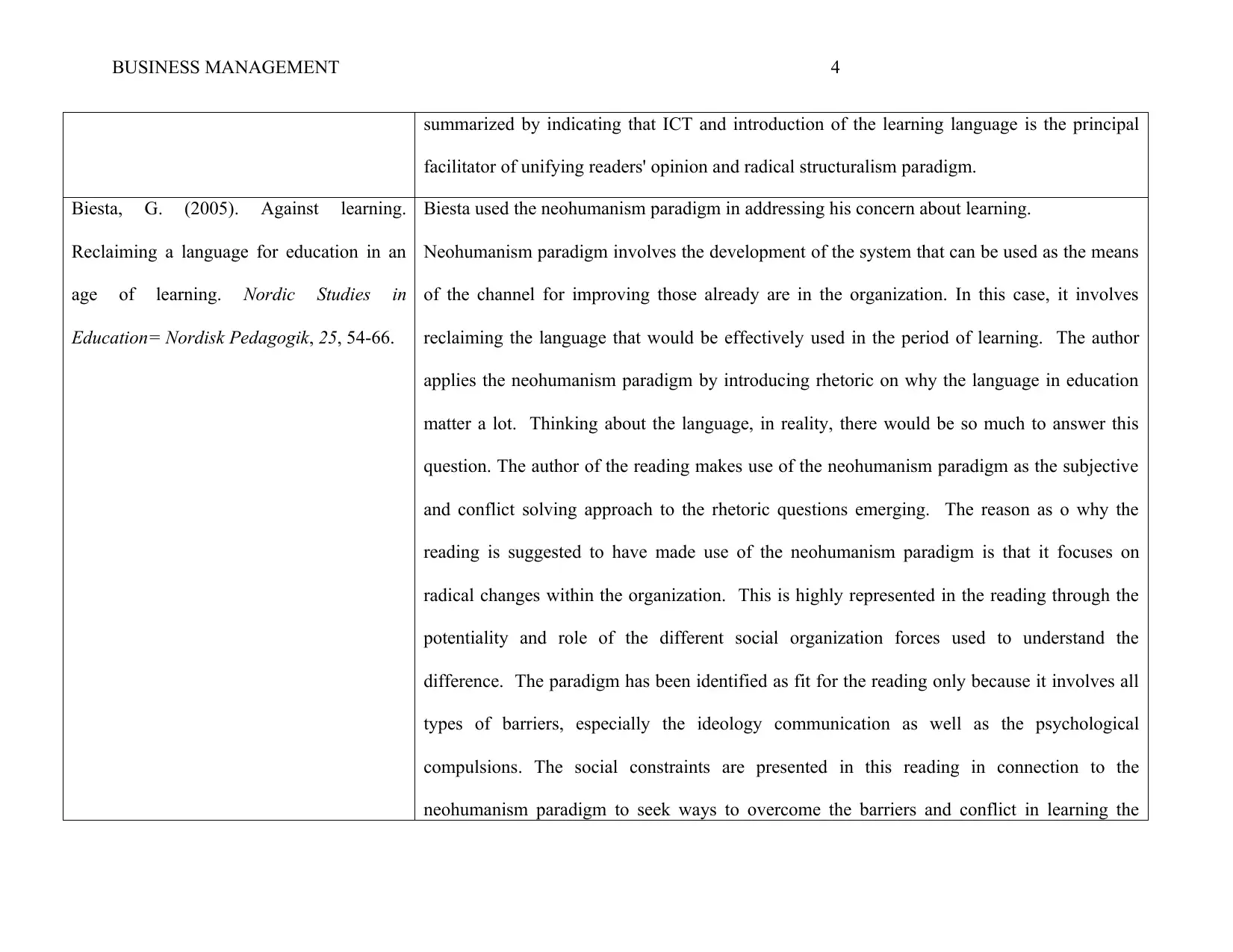
BUSINESS MANAGEMENT 4
summarized by indicating that ICT and introduction of the learning language is the principal
facilitator of unifying readers' opinion and radical structuralism paradigm.
Biesta, G. (2005). Against learning.
Reclaiming a language for education in an
age of learning. Nordic Studies in
Education= Nordisk Pedagogik, 25, 54-66.
Biesta used the neohumanism paradigm in addressing his concern about learning.
Neohumanism paradigm involves the development of the system that can be used as the means
of the channel for improving those already are in the organization. In this case, it involves
reclaiming the language that would be effectively used in the period of learning. The author
applies the neohumanism paradigm by introducing rhetoric on why the language in education
matter a lot. Thinking about the language, in reality, there would be so much to answer this
question. The author of the reading makes use of the neohumanism paradigm as the subjective
and conflict solving approach to the rhetoric questions emerging. The reason as o why the
reading is suggested to have made use of the neohumanism paradigm is that it focuses on
radical changes within the organization. This is highly represented in the reading through the
potentiality and role of the different social organization forces used to understand the
difference. The paradigm has been identified as fit for the reading only because it involves all
types of barriers, especially the ideology communication as well as the psychological
compulsions. The social constraints are presented in this reading in connection to the
neohumanism paradigm to seek ways to overcome the barriers and conflict in learning the
summarized by indicating that ICT and introduction of the learning language is the principal
facilitator of unifying readers' opinion and radical structuralism paradigm.
Biesta, G. (2005). Against learning.
Reclaiming a language for education in an
age of learning. Nordic Studies in
Education= Nordisk Pedagogik, 25, 54-66.
Biesta used the neohumanism paradigm in addressing his concern about learning.
Neohumanism paradigm involves the development of the system that can be used as the means
of the channel for improving those already are in the organization. In this case, it involves
reclaiming the language that would be effectively used in the period of learning. The author
applies the neohumanism paradigm by introducing rhetoric on why the language in education
matter a lot. Thinking about the language, in reality, there would be so much to answer this
question. The author of the reading makes use of the neohumanism paradigm as the subjective
and conflict solving approach to the rhetoric questions emerging. The reason as o why the
reading is suggested to have made use of the neohumanism paradigm is that it focuses on
radical changes within the organization. This is highly represented in the reading through the
potentiality and role of the different social organization forces used to understand the
difference. The paradigm has been identified as fit for the reading only because it involves all
types of barriers, especially the ideology communication as well as the psychological
compulsions. The social constraints are presented in this reading in connection to the
neohumanism paradigm to seek ways to overcome the barriers and conflict in learning the
Secure Best Marks with AI Grader
Need help grading? Try our AI Grader for instant feedback on your assignments.
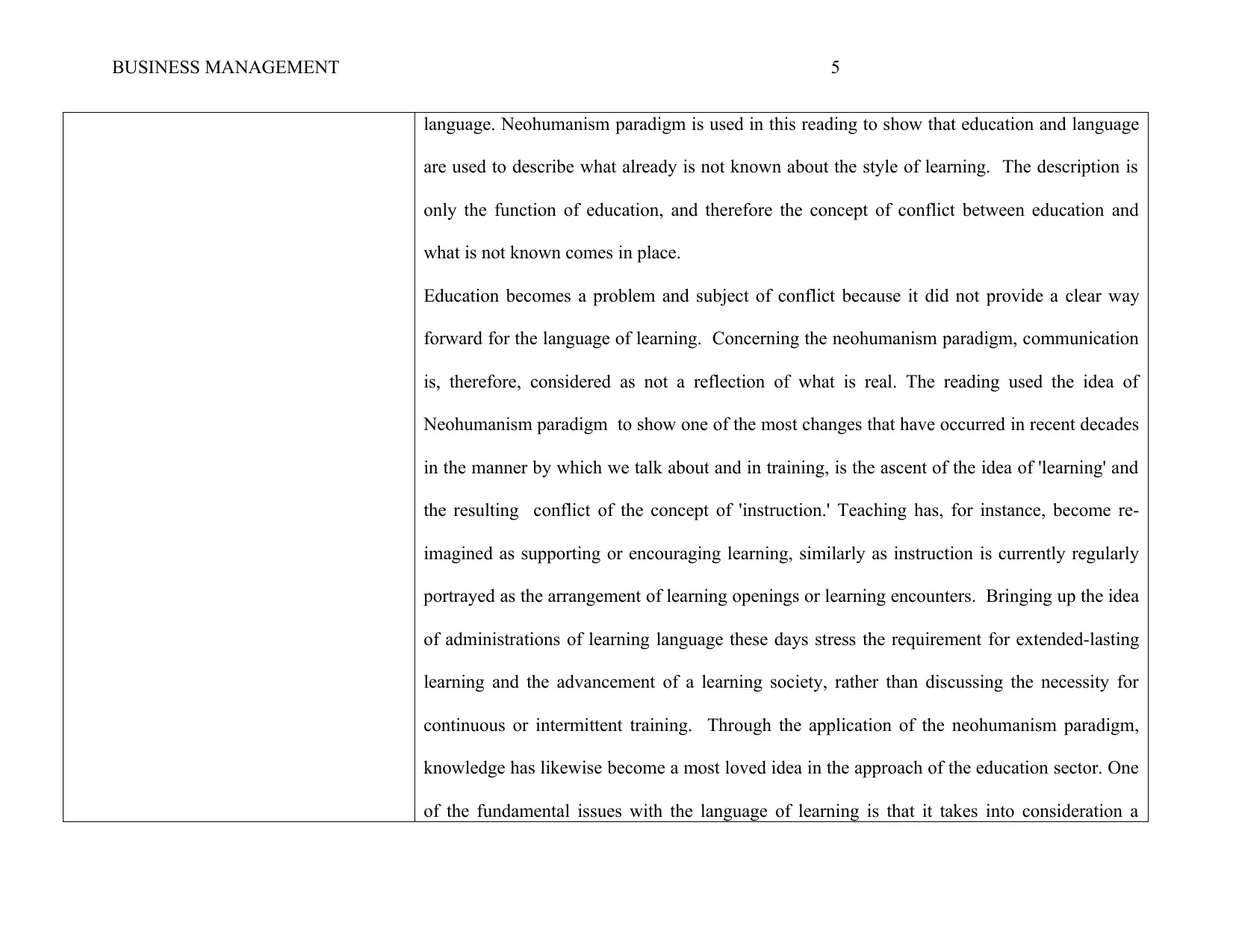
BUSINESS MANAGEMENT 5
language. Neohumanism paradigm is used in this reading to show that education and language
are used to describe what already is not known about the style of learning. The description is
only the function of education, and therefore the concept of conflict between education and
what is not known comes in place.
Education becomes a problem and subject of conflict because it did not provide a clear way
forward for the language of learning. Concerning the neohumanism paradigm, communication
is, therefore, considered as not a reflection of what is real. The reading used the idea of
Neohumanism paradigm to show one of the most changes that have occurred in recent decades
in the manner by which we talk about and in training, is the ascent of the idea of 'learning' and
the resulting conflict of the concept of 'instruction.' Teaching has, for instance, become re-
imagined as supporting or encouraging learning, similarly as instruction is currently regularly
portrayed as the arrangement of learning openings or learning encounters. Bringing up the idea
of administrations of learning language these days stress the requirement for extended-lasting
learning and the advancement of a learning society, rather than discussing the necessity for
continuous or intermittent training. Through the application of the neohumanism paradigm,
knowledge has likewise become a most loved idea in the approach of the education sector. One
of the fundamental issues with the language of learning is that it takes into consideration a
language. Neohumanism paradigm is used in this reading to show that education and language
are used to describe what already is not known about the style of learning. The description is
only the function of education, and therefore the concept of conflict between education and
what is not known comes in place.
Education becomes a problem and subject of conflict because it did not provide a clear way
forward for the language of learning. Concerning the neohumanism paradigm, communication
is, therefore, considered as not a reflection of what is real. The reading used the idea of
Neohumanism paradigm to show one of the most changes that have occurred in recent decades
in the manner by which we talk about and in training, is the ascent of the idea of 'learning' and
the resulting conflict of the concept of 'instruction.' Teaching has, for instance, become re-
imagined as supporting or encouraging learning, similarly as instruction is currently regularly
portrayed as the arrangement of learning openings or learning encounters. Bringing up the idea
of administrations of learning language these days stress the requirement for extended-lasting
learning and the advancement of a learning society, rather than discussing the necessity for
continuous or intermittent training. Through the application of the neohumanism paradigm,
knowledge has likewise become a most loved idea in the approach of the education sector. One
of the fundamental issues with the language of learning is that it takes into consideration a
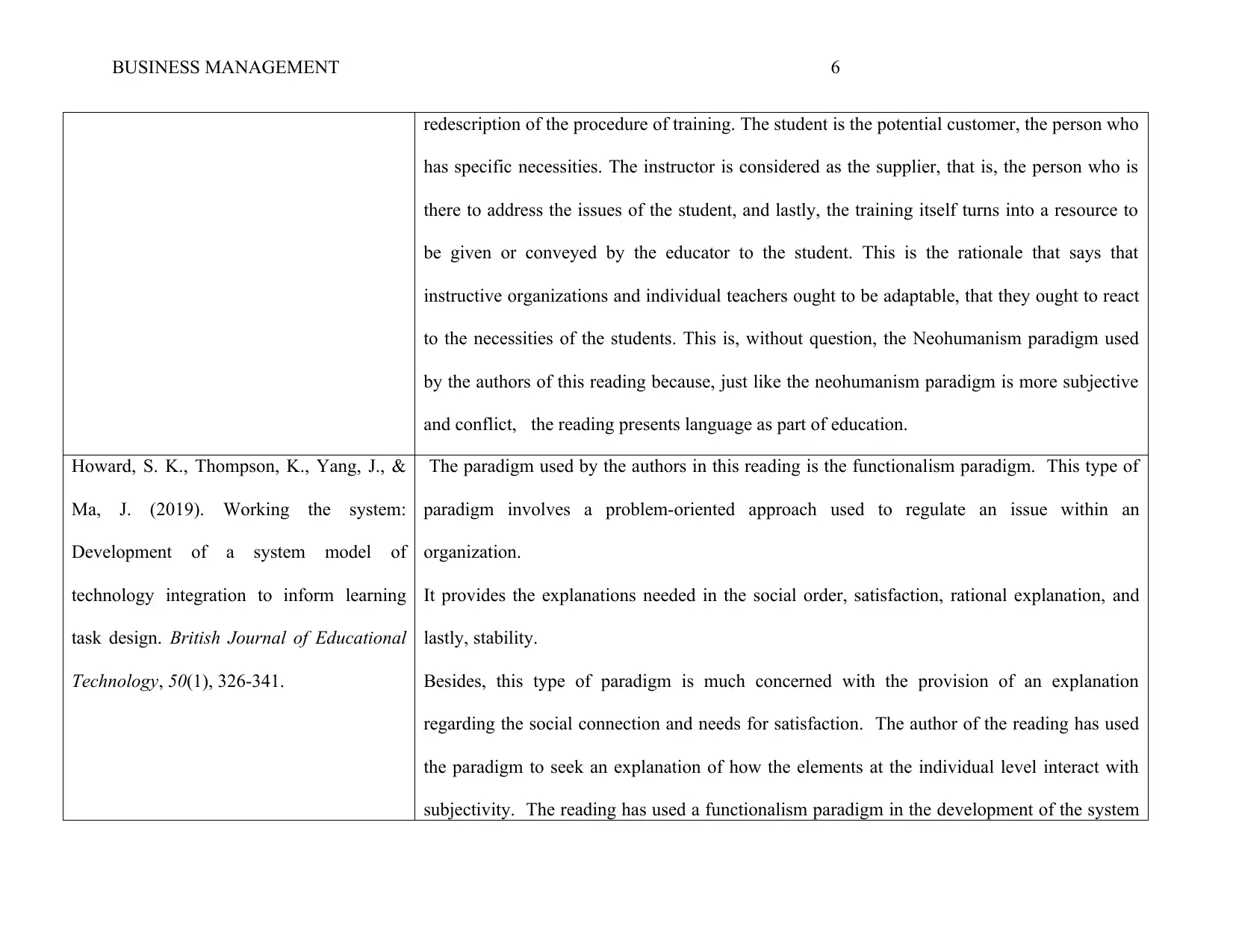
BUSINESS MANAGEMENT 6
redescription of the procedure of training. The student is the potential customer, the person who
has specific necessities. The instructor is considered as the supplier, that is, the person who is
there to address the issues of the student, and lastly, the training itself turns into a resource to
be given or conveyed by the educator to the student. This is the rationale that says that
instructive organizations and individual teachers ought to be adaptable, that they ought to react
to the necessities of the students. This is, without question, the Neohumanism paradigm used
by the authors of this reading because, just like the neohumanism paradigm is more subjective
and conflict, the reading presents language as part of education.
Howard, S. K., Thompson, K., Yang, J., &
Ma, J. (2019). Working the system:
Development of a system model of
technology integration to inform learning
task design. British Journal of Educational
Technology, 50(1), 326-341.
The paradigm used by the authors in this reading is the functionalism paradigm. This type of
paradigm involves a problem-oriented approach used to regulate an issue within an
organization.
It provides the explanations needed in the social order, satisfaction, rational explanation, and
lastly, stability.
Besides, this type of paradigm is much concerned with the provision of an explanation
regarding the social connection and needs for satisfaction. The author of the reading has used
the paradigm to seek an explanation of how the elements at the individual level interact with
subjectivity. The reading has used a functionalism paradigm in the development of the system
redescription of the procedure of training. The student is the potential customer, the person who
has specific necessities. The instructor is considered as the supplier, that is, the person who is
there to address the issues of the student, and lastly, the training itself turns into a resource to
be given or conveyed by the educator to the student. This is the rationale that says that
instructive organizations and individual teachers ought to be adaptable, that they ought to react
to the necessities of the students. This is, without question, the Neohumanism paradigm used
by the authors of this reading because, just like the neohumanism paradigm is more subjective
and conflict, the reading presents language as part of education.
Howard, S. K., Thompson, K., Yang, J., &
Ma, J. (2019). Working the system:
Development of a system model of
technology integration to inform learning
task design. British Journal of Educational
Technology, 50(1), 326-341.
The paradigm used by the authors in this reading is the functionalism paradigm. This type of
paradigm involves a problem-oriented approach used to regulate an issue within an
organization.
It provides the explanations needed in the social order, satisfaction, rational explanation, and
lastly, stability.
Besides, this type of paradigm is much concerned with the provision of an explanation
regarding the social connection and needs for satisfaction. The author of the reading has used
the paradigm to seek an explanation of how the elements at the individual level interact with
subjectivity. The reading has used a functionalism paradigm in the development of the system
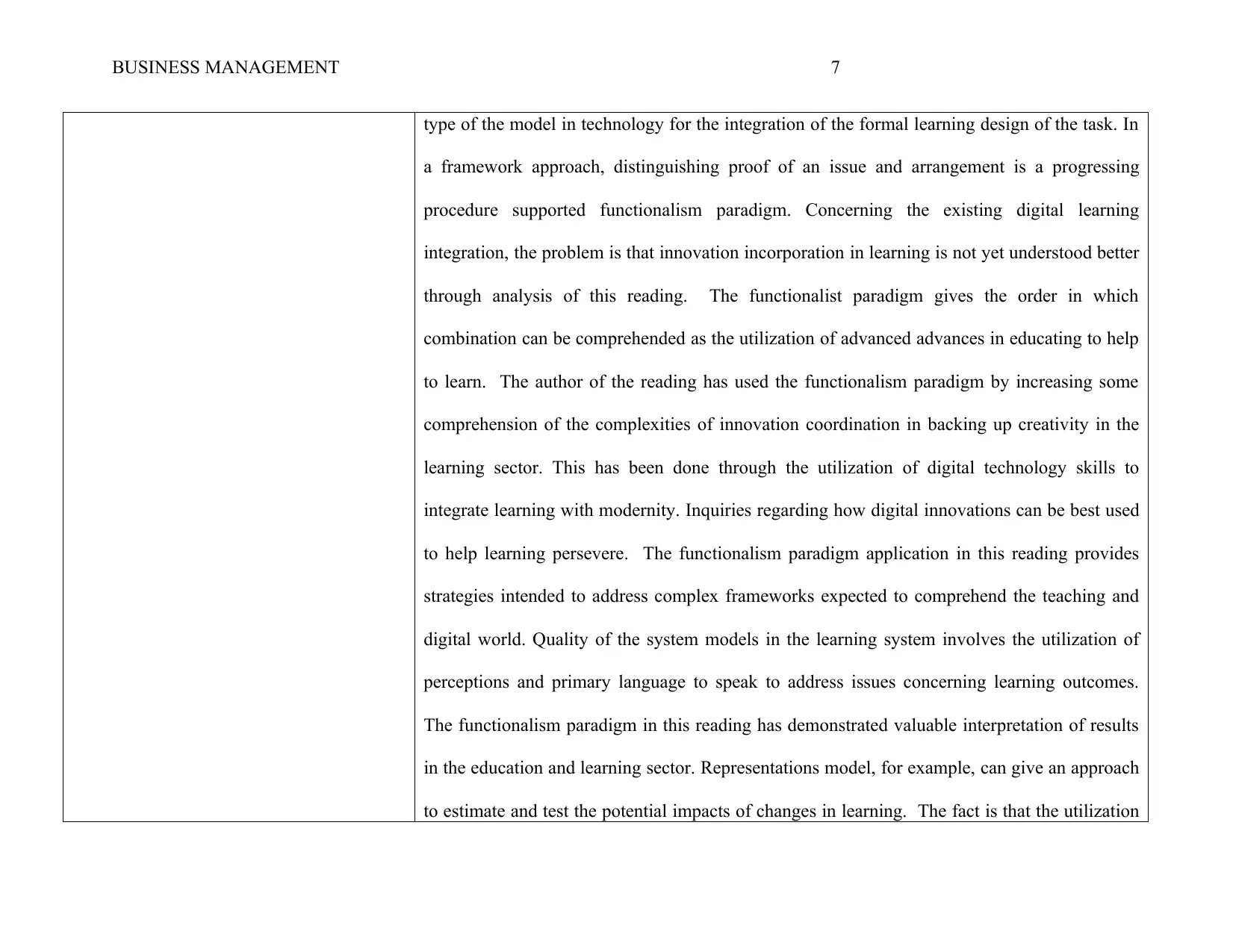
BUSINESS MANAGEMENT 7
type of the model in technology for the integration of the formal learning design of the task. In
a framework approach, distinguishing proof of an issue and arrangement is a progressing
procedure supported functionalism paradigm. Concerning the existing digital learning
integration, the problem is that innovation incorporation in learning is not yet understood better
through analysis of this reading. The functionalist paradigm gives the order in which
combination can be comprehended as the utilization of advanced advances in educating to help
to learn. The author of the reading has used the functionalism paradigm by increasing some
comprehension of the complexities of innovation coordination in backing up creativity in the
learning sector. This has been done through the utilization of digital technology skills to
integrate learning with modernity. Inquiries regarding how digital innovations can be best used
to help learning persevere. The functionalism paradigm application in this reading provides
strategies intended to address complex frameworks expected to comprehend the teaching and
digital world. Quality of the system models in the learning system involves the utilization of
perceptions and primary language to speak to address issues concerning learning outcomes.
The functionalism paradigm in this reading has demonstrated valuable interpretation of results
in the education and learning sector. Representations model, for example, can give an approach
to estimate and test the potential impacts of changes in learning. The fact is that the utilization
type of the model in technology for the integration of the formal learning design of the task. In
a framework approach, distinguishing proof of an issue and arrangement is a progressing
procedure supported functionalism paradigm. Concerning the existing digital learning
integration, the problem is that innovation incorporation in learning is not yet understood better
through analysis of this reading. The functionalist paradigm gives the order in which
combination can be comprehended as the utilization of advanced advances in educating to help
to learn. The author of the reading has used the functionalism paradigm by increasing some
comprehension of the complexities of innovation coordination in backing up creativity in the
learning sector. This has been done through the utilization of digital technology skills to
integrate learning with modernity. Inquiries regarding how digital innovations can be best used
to help learning persevere. The functionalism paradigm application in this reading provides
strategies intended to address complex frameworks expected to comprehend the teaching and
digital world. Quality of the system models in the learning system involves the utilization of
perceptions and primary language to speak to address issues concerning learning outcomes.
The functionalism paradigm in this reading has demonstrated valuable interpretation of results
in the education and learning sector. Representations model, for example, can give an approach
to estimate and test the potential impacts of changes in learning. The fact is that the utilization
Paraphrase This Document
Need a fresh take? Get an instant paraphrase of this document with our AI Paraphraser
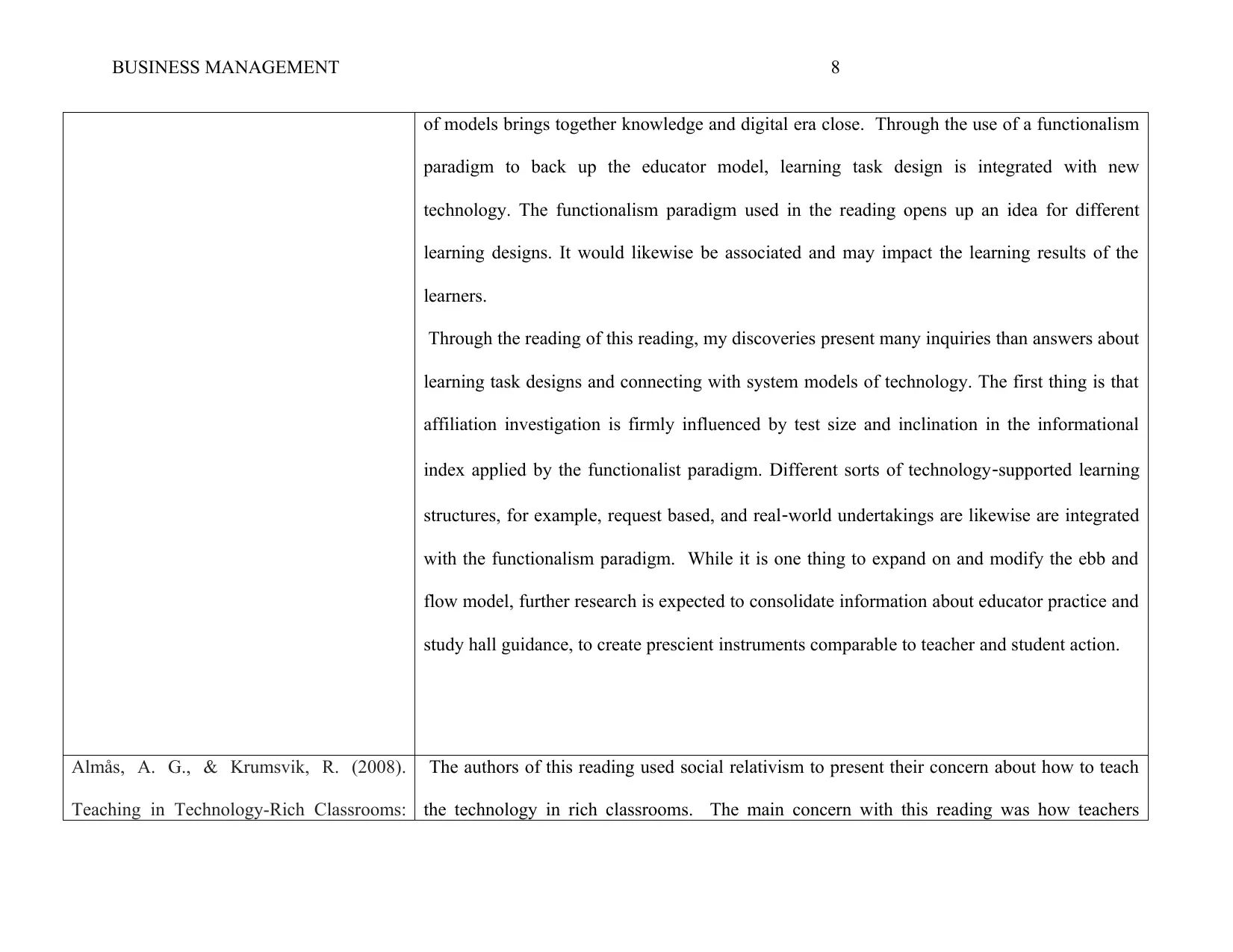
BUSINESS MANAGEMENT 8
of models brings together knowledge and digital era close. Through the use of a functionalism
paradigm to back up the educator model, learning task design is integrated with new
technology. The functionalism paradigm used in the reading opens up an idea for different
learning designs. It would likewise be associated and may impact the learning results of the
learners.
Through the reading of this reading, my discoveries present many inquiries than answers about
learning task designs and connecting with system models of technology. The first thing is that
affiliation investigation is firmly influenced by test size and inclination in the informational
index applied by the functionalist paradigm. Different sorts of technology‐supported learning
structures, for example, request based, and real‐world undertakings are likewise are integrated
with the functionalism paradigm. While it is one thing to expand on and modify the ebb and
flow model, further research is expected to consolidate information about educator practice and
study hall guidance, to create prescient instruments comparable to teacher and student action.
Almås, A. G., & Krumsvik, R. (2008).
Teaching in Technology-Rich Classrooms:
The authors of this reading used social relativism to present their concern about how to teach
the technology in rich classrooms. The main concern with this reading was how teachers
of models brings together knowledge and digital era close. Through the use of a functionalism
paradigm to back up the educator model, learning task design is integrated with new
technology. The functionalism paradigm used in the reading opens up an idea for different
learning designs. It would likewise be associated and may impact the learning results of the
learners.
Through the reading of this reading, my discoveries present many inquiries than answers about
learning task designs and connecting with system models of technology. The first thing is that
affiliation investigation is firmly influenced by test size and inclination in the informational
index applied by the functionalist paradigm. Different sorts of technology‐supported learning
structures, for example, request based, and real‐world undertakings are likewise are integrated
with the functionalism paradigm. While it is one thing to expand on and modify the ebb and
flow model, further research is expected to consolidate information about educator practice and
study hall guidance, to create prescient instruments comparable to teacher and student action.
Almås, A. G., & Krumsvik, R. (2008).
Teaching in Technology-Rich Classrooms:
The authors of this reading used social relativism to present their concern about how to teach
the technology in rich classrooms. The main concern with this reading was how teachers
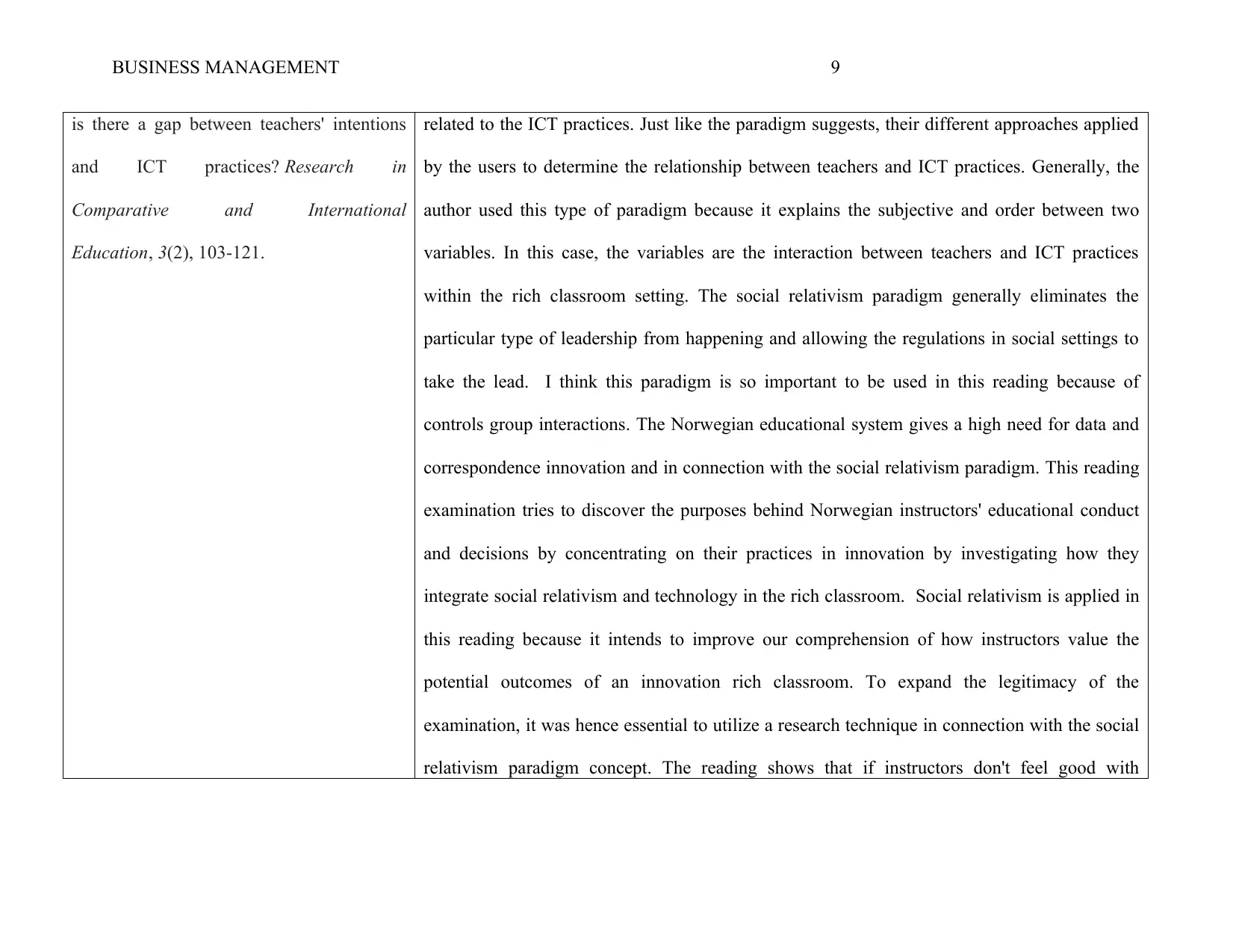
BUSINESS MANAGEMENT 9
is there a gap between teachers' intentions
and ICT practices? Research in
Comparative and International
Education, 3(2), 103-121.
related to the ICT practices. Just like the paradigm suggests, their different approaches applied
by the users to determine the relationship between teachers and ICT practices. Generally, the
author used this type of paradigm because it explains the subjective and order between two
variables. In this case, the variables are the interaction between teachers and ICT practices
within the rich classroom setting. The social relativism paradigm generally eliminates the
particular type of leadership from happening and allowing the regulations in social settings to
take the lead. I think this paradigm is so important to be used in this reading because of
controls group interactions. The Norwegian educational system gives a high need for data and
correspondence innovation and in connection with the social relativism paradigm. This reading
examination tries to discover the purposes behind Norwegian instructors' educational conduct
and decisions by concentrating on their practices in innovation by investigating how they
integrate social relativism and technology in the rich classroom. Social relativism is applied in
this reading because it intends to improve our comprehension of how instructors value the
potential outcomes of an innovation rich classroom. To expand the legitimacy of the
examination, it was hence essential to utilize a research technique in connection with the social
relativism paradigm concept. The reading shows that if instructors don't feel good with
is there a gap between teachers' intentions
and ICT practices? Research in
Comparative and International
Education, 3(2), 103-121.
related to the ICT practices. Just like the paradigm suggests, their different approaches applied
by the users to determine the relationship between teachers and ICT practices. Generally, the
author used this type of paradigm because it explains the subjective and order between two
variables. In this case, the variables are the interaction between teachers and ICT practices
within the rich classroom setting. The social relativism paradigm generally eliminates the
particular type of leadership from happening and allowing the regulations in social settings to
take the lead. I think this paradigm is so important to be used in this reading because of
controls group interactions. The Norwegian educational system gives a high need for data and
correspondence innovation and in connection with the social relativism paradigm. This reading
examination tries to discover the purposes behind Norwegian instructors' educational conduct
and decisions by concentrating on their practices in innovation by investigating how they
integrate social relativism and technology in the rich classroom. Social relativism is applied in
this reading because it intends to improve our comprehension of how instructors value the
potential outcomes of an innovation rich classroom. To expand the legitimacy of the
examination, it was hence essential to utilize a research technique in connection with the social
relativism paradigm concept. The reading shows that if instructors don't feel good with
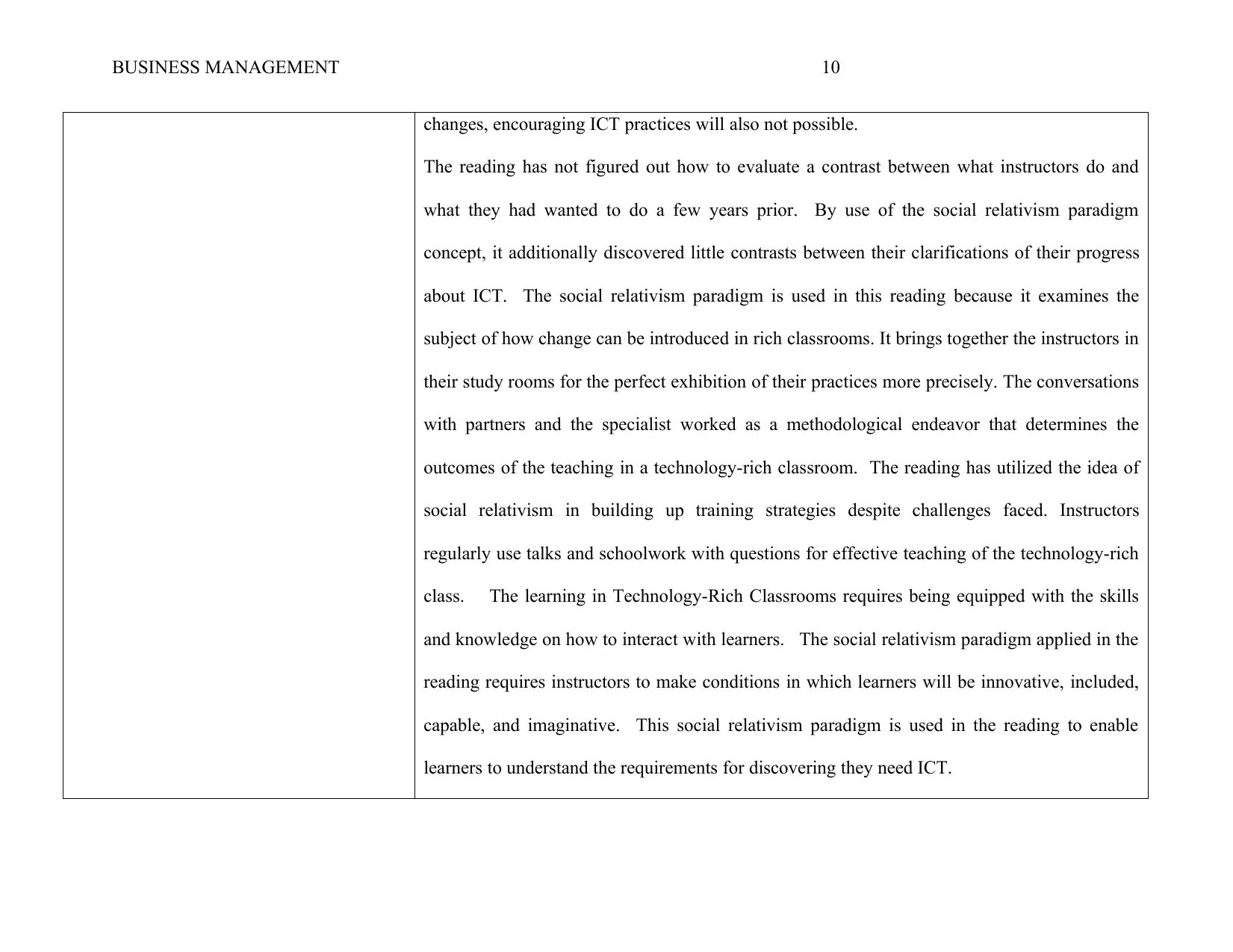
BUSINESS MANAGEMENT 10
changes, encouraging ICT practices will also not possible.
The reading has not figured out how to evaluate a contrast between what instructors do and
what they had wanted to do a few years prior. By use of the social relativism paradigm
concept, it additionally discovered little contrasts between their clarifications of their progress
about ICT. The social relativism paradigm is used in this reading because it examines the
subject of how change can be introduced in rich classrooms. It brings together the instructors in
their study rooms for the perfect exhibition of their practices more precisely. The conversations
with partners and the specialist worked as a methodological endeavor that determines the
outcomes of the teaching in a technology-rich classroom. The reading has utilized the idea of
social relativism in building up training strategies despite challenges faced. Instructors
regularly use talks and schoolwork with questions for effective teaching of the technology-rich
class. The learning in Technology-Rich Classrooms requires being equipped with the skills
and knowledge on how to interact with learners. The social relativism paradigm applied in the
reading requires instructors to make conditions in which learners will be innovative, included,
capable, and imaginative. This social relativism paradigm is used in the reading to enable
learners to understand the requirements for discovering they need ICT.
changes, encouraging ICT practices will also not possible.
The reading has not figured out how to evaluate a contrast between what instructors do and
what they had wanted to do a few years prior. By use of the social relativism paradigm
concept, it additionally discovered little contrasts between their clarifications of their progress
about ICT. The social relativism paradigm is used in this reading because it examines the
subject of how change can be introduced in rich classrooms. It brings together the instructors in
their study rooms for the perfect exhibition of their practices more precisely. The conversations
with partners and the specialist worked as a methodological endeavor that determines the
outcomes of the teaching in a technology-rich classroom. The reading has utilized the idea of
social relativism in building up training strategies despite challenges faced. Instructors
regularly use talks and schoolwork with questions for effective teaching of the technology-rich
class. The learning in Technology-Rich Classrooms requires being equipped with the skills
and knowledge on how to interact with learners. The social relativism paradigm applied in the
reading requires instructors to make conditions in which learners will be innovative, included,
capable, and imaginative. This social relativism paradigm is used in the reading to enable
learners to understand the requirements for discovering they need ICT.
Secure Best Marks with AI Grader
Need help grading? Try our AI Grader for instant feedback on your assignments.
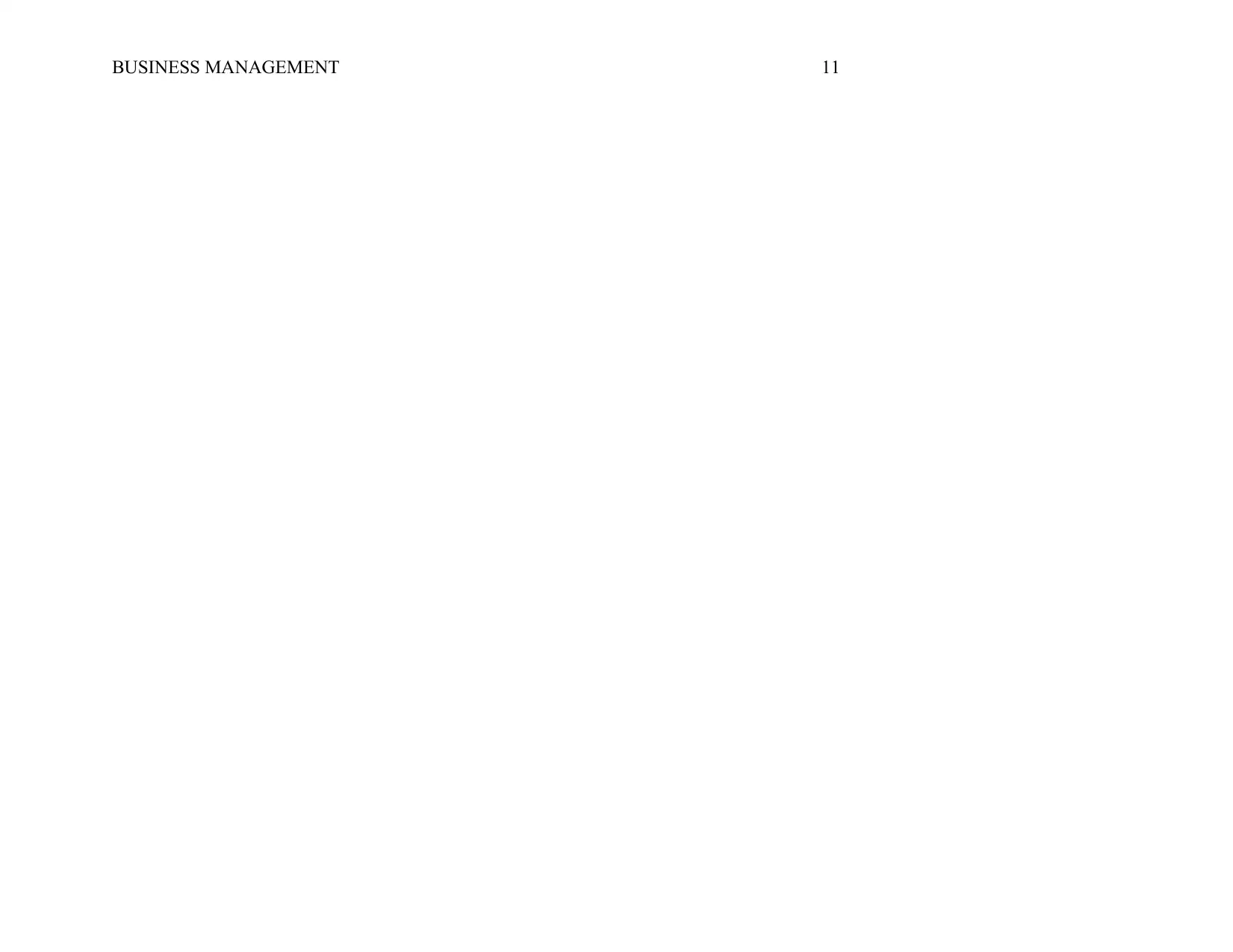
BUSINESS MANAGEMENT 11
1 out of 11
Your All-in-One AI-Powered Toolkit for Academic Success.
+13062052269
info@desklib.com
Available 24*7 on WhatsApp / Email
![[object Object]](/_next/static/media/star-bottom.7253800d.svg)
Unlock your academic potential
© 2024 | Zucol Services PVT LTD | All rights reserved.




